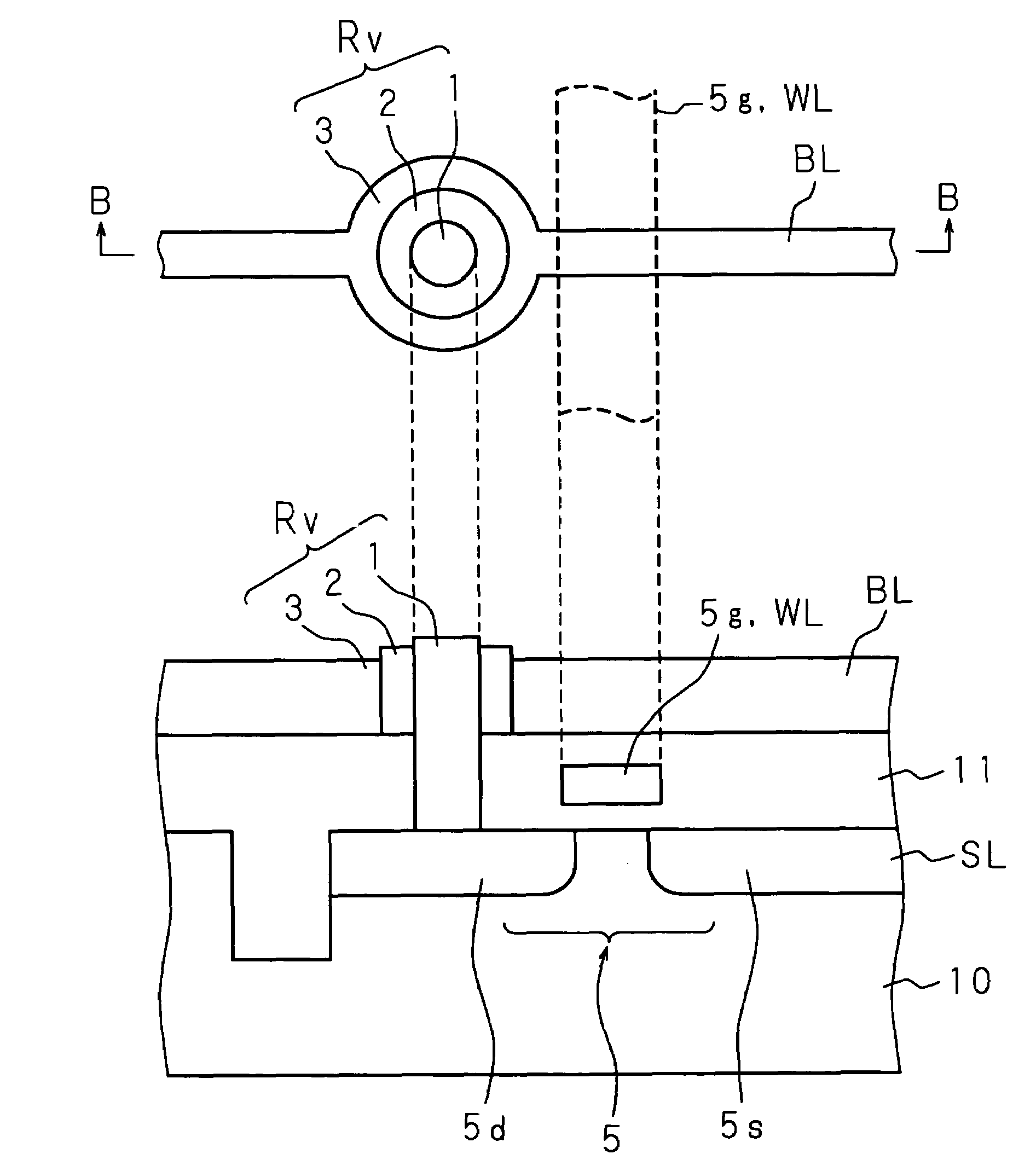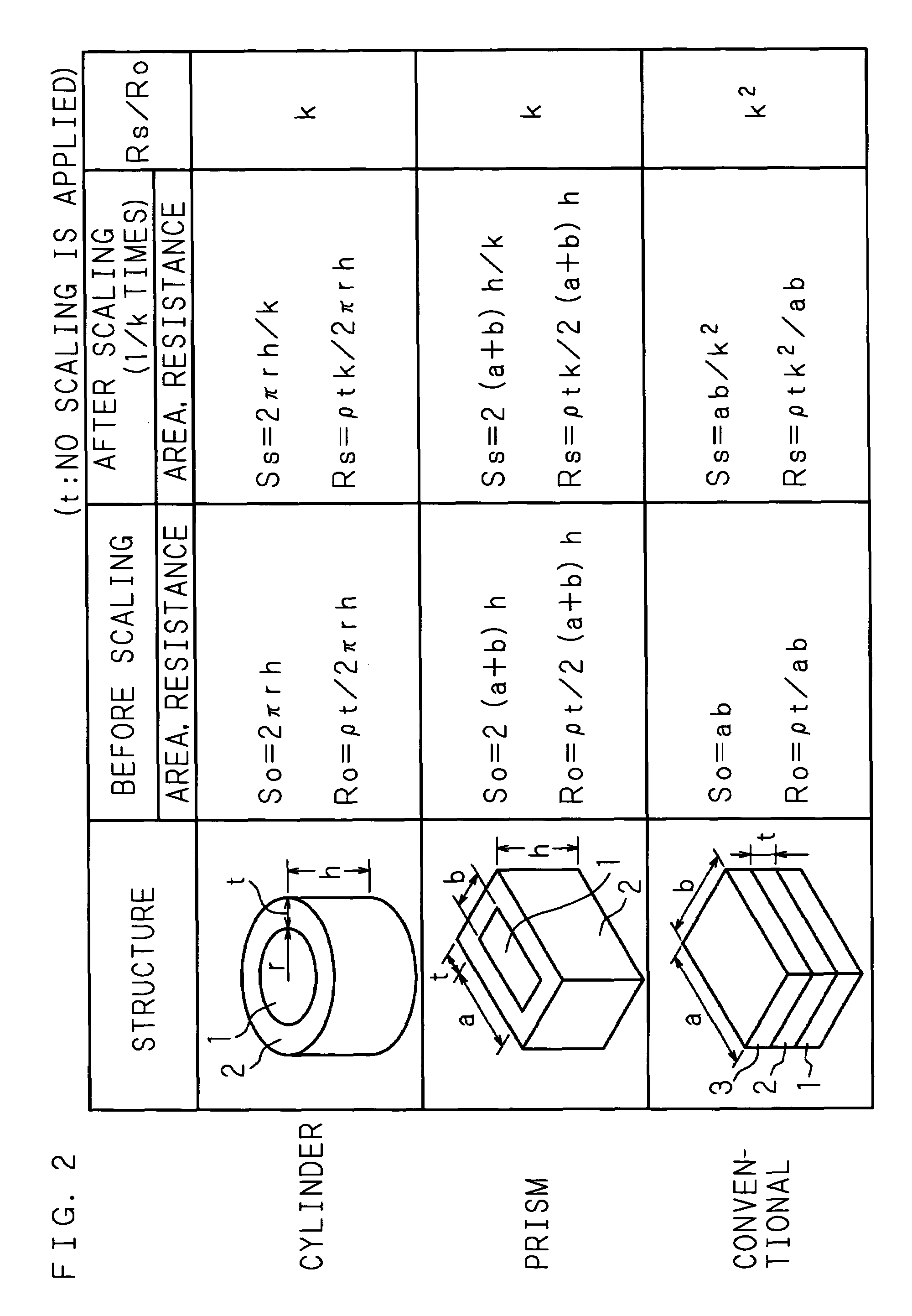Nonvolatile variable resistor, memory device, and scaling method of nonvolatile variable resistor
a nonvolatile variable resistor and resistor scaling technology, applied in semiconductor devices, digital storage, instruments, etc., can solve the problems of slow operation, decreased operating speed, especially read speed, etc., and achieve reduced projection area, large capacity, and suppressed resistance of nonvolatile variable resistors
- Summary
- Abstract
- Description
- Claims
- Application Information
AI Technical Summary
Benefits of technology
Problems solved by technology
Method used
Image
Examples
first embodiment
[0065]FIGS. 1A and 1B are descriptive views showing a way of scaling in a nonvolatile variable resistor according to a first embodiment. FIG. 1A is a perspective view of the nonvolatile variable resistor Rv before scaling is applied. FIG. 1B is a perspective view of the nonvolatile variable resistor Rv after scaling is applied at a magnification of 1 / k times (k>1) thereto. In FIG. 1A, the nonvolatile variable resistor Rv is formed with a first electrode 1 in the shape of a column of a height h and a radius r as an inner electrode. A nonvolatile variable resistance body 2 in a cylindrical shape is formed on an outer surface of the first electrode 1 in a layer with a film thickness t and a second electrode 3 in a cylindrical shape of a radius r+t is formed as an outer electrode on an outer surface of the nonvolatile variable resistance body 2 so as to face the first electrode 1. The second electrode 3 is concentric about the first electrode 1.
[0066]In FIG. 1B, the nonvolatile variable...
second embodiment
[0083]FIGS. 4A and 4B are descriptive views for describing a structure of a 1T1R type memory cell in a memory device according to a second embodiment. There is shown a 1T1R type memory cell using a transistor (a MOS transistor 5) as a selective device for selecting a nonvolatile variable resistor Rv. FIG. 4A shows a schematic plan view and FIG. 4B shows a schematic sectional view taken along line B-B of FIG. 4A. A drain 5d and a source 5s of the MOS transistor 5 are formed on a substrate 10 made of a single crystal silicon or the like. A gate electrode 5g is formed in an insulating layer 11 formed on a surface of the substrate 10 at positions corresponding to the drain 5d and source 5s. The insulating layer 11 is made of, for example, a silicon oxide film and the gate electrode 5g is made of, for example, polysilicon, a high melting point metal or the like. The drain 5d is connected to a first electrode 1 of a nonvolatile variable resistor Rv.
[0084]The first electrode 1 is formed on...
third embodiment
[0096]FIGS. 6A to 6D are descriptive views for describing a way of scaling in a nonvolatile variable resistor according to a third embodiment. FIG. 6A is a plan view of a nonvolatile variable resistor Rv (of a columnar structure) before scaling, and FIG. B is a sectional view taken along a radial direction of FIG. 6A. FIG. 6C is a plan view of a nonvolatile variable resistor Rv after scaling is applied to the nonvolatile variable resistor Rv in FIG. 6A at a magnification of 1 / k times (k>1), and FIG. 6D is a sectional view taken along a radial direction of FIG. 6C.
[0097]Similar to the cases of the first and second embodiments, a first electrode 1 is formed as a column, a nonvolatile variable resistance body 2 in the shape of a cylinder is formed on an outer surface of the first electrode 1 and a second electrode 3 in the shape of a cylinder is further formed as an outer electrode on an outer surface of the nonvolatile variable resistance body 2 so as to face the first electrode 1. No...
PUM
 Login to View More
Login to View More Abstract
Description
Claims
Application Information
 Login to View More
Login to View More - R&D
- Intellectual Property
- Life Sciences
- Materials
- Tech Scout
- Unparalleled Data Quality
- Higher Quality Content
- 60% Fewer Hallucinations
Browse by: Latest US Patents, China's latest patents, Technical Efficacy Thesaurus, Application Domain, Technology Topic, Popular Technical Reports.
© 2025 PatSnap. All rights reserved.Legal|Privacy policy|Modern Slavery Act Transparency Statement|Sitemap|About US| Contact US: help@patsnap.com



